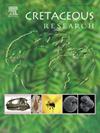Torreites milovanovici Grubić, 1979 in the Iranian Upper Cretaceous succession: Paleoenvironmental characteristics
IF 1.7
3区 地球科学
Q1 GEOLOGY
引用次数: 0
Abstract
Genus Torreites shows different features in comparison to other types of rudists, making them important to interpret paleoenvironmental circumstances. In the study area which is located north of Shiraz (Zagros Basin, Interior Fars) (i.e. the northwesternmost section of Torreites-bearing sections of the Middle East) about 40 specimens from the Iranian section were analyzed to interpret the paleoecological characteristics of the Campanian monospecific layer. At first sight, their morphotypes reveal the substrate, hydrodynamic energy, and other factors. Except for a limited number of specimens, they predominantly function as elevators, indicating a relatively quiet surrounding environment. There are minor organisms, including corals, gastropods, sponges, other non-rudist bivalve groups, and polychaeta, helping for more precise interpretations. The Torreites-bearing carbonate layer is situated on a soft shaly and marly siliciclastic bed, and other organisms colonized a considerable proportion of the surface of Torreites specimens. As they are photosymbiont-bearing bivalves, they may play a significant role in interpreting environmental characteristics such as trophic conditions. In addition, as surface bioerosion increases in response to elevated nutrient levels, the prevailing trophic condition is supposed to be oligotrophic to mesotrophic. Also, based on marine constituents, and previous studies, the studied interval must be deposited in a tropical environment. Based on various interpretations, hydrodynamic energy has transitioned from low to moderate levels. Besides, bioerosion rates observed on different sides and coupled specimens imply that Torreites samples should have preferred directions.
Torreites milovanovici Grubić, 1979 年,伊朗上白垩世演替:古环境特征
鸟雷属与其他类型的原始动物相比表现出不同的特征,使它们对解释古环境环境具有重要意义。研究区位于设拉子北部(内法尔斯Zagros盆地),即中东含torreites剖面的最西北端,对伊朗剖面约40个样品进行了分析,以解释坎帕尼亚单特异层的古生态特征。乍一看,它们的形态揭示了基质、水动力能和其他因素。除了数量有限的标本外,它们主要用作电梯,表明周围环境相对安静。还有一些较小的生物,包括珊瑚、腹足类动物、海绵、其他非rudist双壳类动物和多毛纲动物,有助于更精确的解释。含Torreites的碳酸盐层位于柔软的泥质和灰岩质硅质地层上,其他生物在Torreites标本的表面占据了相当大的比例。由于它们是光共生双壳类,它们可能在解释营养条件等环境特征方面发挥重要作用。此外,由于地表生物侵蚀随着营养水平的升高而增加,普遍的营养状况应该是少营养到中营养的。此外,根据海洋成分和以前的研究,所研究的层段必须沉积在热带环境中。根据各种解释,水动力能已经从低水平过渡到中等水平。此外,在不同侧面和耦合标本上观察到的生物侵蚀速率表明,Torreites样品应该有优先的方向。
本文章由计算机程序翻译,如有差异,请以英文原文为准。
求助全文
约1分钟内获得全文
求助全文
来源期刊

Cretaceous Research
地学-地质学
CiteScore
4.10
自引率
19.00%
发文量
235
审稿时长
12 weeks
期刊介绍:
Cretaceous Research provides a forum for the rapid publication of research on all aspects of the Cretaceous Period, including its boundaries with the Jurassic and Palaeogene. Authoritative papers reporting detailed investigations of Cretaceous stratigraphy and palaeontology, studies of regional geology, and reviews of recently published books are complemented by short communications of significant new findings.
Papers submitted to Cretaceous Research should place the research in a broad context, with emphasis placed towards our better understanding of the Cretaceous, that are therefore of interest to the diverse, international readership of the journal. Full length papers that focus solely on a local theme or area will not be accepted for publication; authors of short communications are encouraged to discuss how their findings are of relevance to the Cretaceous on a broad scale.
Research Areas include:
• Regional geology
• Stratigraphy and palaeontology
• Palaeobiology
• Palaeobiogeography
• Palaeoceanography
• Palaeoclimatology
• Evolutionary Palaeoecology
• Geochronology
• Global events.
 求助内容:
求助内容: 应助结果提醒方式:
应助结果提醒方式:


